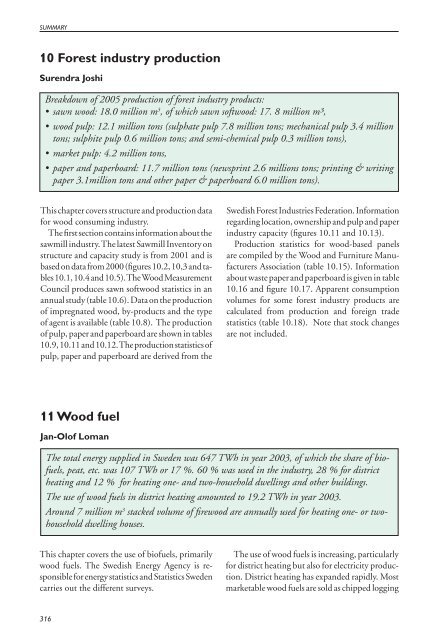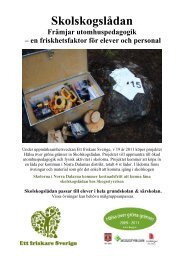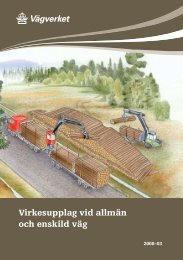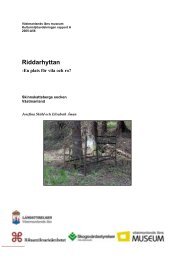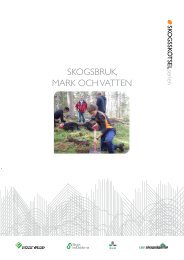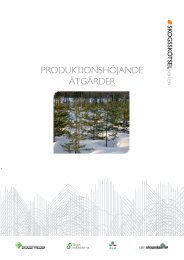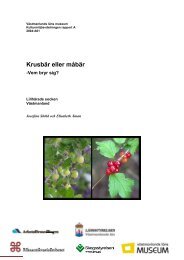- Page 1 and 2:
TRÄDBRÄNSLE
- Page 3 and 4:
Statistical Yearbook of Forestry 20
- Page 5 and 6:
KAPITELFÖRTECKNING CHAPTER LIST Ka
- Page 7 and 8:
INNEHÅLL Skogsmarksareal/ägargrup
- Page 9 and 10:
INNEHÅLL TEXT Beskrivning av stati
- Page 11 and 12:
INNEHÅLL Träimpregnering ........
- Page 13 and 14:
INNEHÅLL Investeringar inom skogsi
- Page 15 and 16:
CONTENTS Contents (English summary
- Page 17 and 18:
CONTENTS Chapter 5 Nature and envir
- Page 19 and 20:
CONTENTS Areas of final felling, 7.
- Page 21 and 22:
CONTENTS Self-activity in small sca
- Page 23 and 24:
CONTENTS Appendixes ...............
- Page 25 and 26:
INLEDNING INTRODUCTION Introduction
- Page 27 and 28:
1 SKOGLIG STATISTIKPRODUKTION THE P
- Page 29 and 30:
1 SKOGLIG STATISTIKPRODUKTION THE P
- Page 31 and 32:
2 FASTIGHETS- OCH ÄGARSTRUKTUR EST
- Page 33 and 34:
2 FASTIGHETS- OCH ÄGARSTRUKTUR EST
- Page 35 and 36:
2 FASTIGHETS- OCH ÄGARSTRUKTUR EST
- Page 37 and 38:
2 FASTIGHETS- OCH ÄGARSTRUKTUR EST
- Page 39 and 40:
2 FASTIGHETS- OCH ÄGARSTRUKTUR EST
- Page 41 and 42:
2 FASTIGHETS- OCH ÄGARSTRUKTUR EST
- Page 43 and 44:
2 FASTIGHETS- OCH ÄGARSTRUKTUR EST
- Page 45 and 46:
3 SKOG OCH SKOGSMARK FOREST AND FOR
- Page 47 and 48:
3 SKOG OCH SKOGSMARK FOREST AND FOR
- Page 49 and 50:
3 SKOG OCH SKOGSMARK FOREST AND FOR
- Page 51 and 52:
3 SKOG OCH SKOGSMARK FOREST AND FOR
- Page 53 and 54:
3 SKOG OCH SKOGSMARK FOREST AND FOR
- Page 55 and 56:
3 SKOG OCH SKOGSMARK FOREST AND FOR
- Page 57 and 58:
3 SKOG OCH SKOGSMARK FOREST AND FOR
- Page 59 and 60:
3 SKOG OCH SKOGSMARK FOREST AND FOR
- Page 61 and 62:
3 SKOG OCH SKOGSMARK FOREST AND FOR
- Page 63 and 64:
3 SKOG OCH SKOGSMARK FOREST AND FOR
- Page 65 and 66:
3 SKOG OCH SKOGSMARK FOREST AND FOR
- Page 67 and 68:
3 SKOG OCH SKOGSMARK FOREST AND FOR
- Page 69 and 70:
3 SKOG OCH SKOGSMARK FOREST AND FOR
- Page 71 and 72:
4 SKADOR PÅ SKOGEN FOREST DAMAGE
- Page 73 and 74:
4 SKADOR PÅ SKOGEN FOREST DAMAGE F
- Page 75 and 76:
4 SKADOR PÅ SKOGEN FOREST DAMAGE T
- Page 77 and 78:
4 SKADOR PÅ SKOGEN FOREST DAMAGE T
- Page 79 and 80:
5 NATUR OCH MILJÖ NATURE AND ENVIR
- Page 81 and 82:
5 NATUR OCH MILJÖ NATURE AND ENVIR
- Page 83 and 84:
5 NATUR OCH MILJÖ NATURE AND ENVIR
- Page 85 and 86:
5 NATUR OCH MILJÖ NATURE AND ENVIR
- Page 87 and 88:
5 NATUR OCH MILJÖ NATURE AND ENVIR
- Page 89 and 90:
5 NATUR OCH MILJÖ NATURE AND ENVIR
- Page 91 and 92:
5 NATUR OCH MILJÖ NATURE AND ENVIR
- Page 93 and 94:
5 NATUR OCH MILJÖ NATURE AND ENVIR
- Page 95 and 96:
5 NATUR OCH MILJÖ NATURE AND ENVIR
- Page 97 and 98:
5 NATUR OCH MILJÖ NATURE AND ENVIR
- Page 99 and 100:
5 NATUR OCH MILJÖ NATURE AND ENVIR
- Page 101 and 102:
5 NATUR OCH MILJÖ NATURE AND ENVIR
- Page 103 and 104:
5 NATUR OCH MILJÖ NATURE AND ENVIR
- Page 105 and 106:
5 NATUR OCH MILJÖ NATURE AND ENVIR
- Page 107 and 108:
5 NATUR OCH MILJÖ NATURE AND ENVIR
- Page 109 and 110:
5 NATUR OCH MILJÖ NATURE AND ENVIR
- Page 111 and 112:
5 NATUR OCH MILJÖ NATURE AND ENVIR
- Page 113 and 114:
5 NATUR OCH MILJÖ NATURE AND ENVIR
- Page 115 and 116:
5 NATUR OCH MILJÖ NATURE AND ENVIR
- Page 117 and 118:
5 NATUR OCH MILJÖ NATURE AND ENVIR
- Page 119 and 120:
6 SKOGSVÅRD SILVICULTURE 6 Skogsv
- Page 121 and 122:
6 SKOGSVÅRD SILVICULTURE Tabell 6.
- Page 123 and 124:
6 SKOGSVÅRD SILVICULTURE Tabell 6.
- Page 125 and 126:
6 SKOGSVÅRD SILVICULTURE Tabell 6.
- Page 127 and 128:
6 SKOGSVÅRD SILVICULTURE Tabell 6.
- Page 129 and 130:
6 SKOGSVÅRD SILVICULTURE Figur 6.1
- Page 131 and 132:
6 SKOGSVÅRD SILVICULTURE Tabell 6.
- Page 133 and 134:
6 SKOGSVÅRD SILVICULTURE Figur 6.1
- Page 135 and 136:
6 SKOGSVÅRD SILVICULTURE Tabell 6.
- Page 137 and 138:
6 SKOGSVÅRD SILVICULTURE Tabell 6.
- Page 139 and 140:
7 AVVERKNING OCH VIRKESMÄTNING FEL
- Page 141 and 142:
7 AVVERKNING OCH VIRKESMÄTNING FEL
- Page 143 and 144:
7 AVVERKNING OCH VIRKESMÄTNING FEL
- Page 145 and 146:
7 AVVERKNING OCH VIRKESMÄTNING FEL
- Page 147 and 148:
7 AVVERKNING OCH VIRKESMÄTNING FEL
- Page 149 and 150:
7 AVVERKNING OCH VIRKESMÄTNING FEL
- Page 151 and 152:
7 AVVERKNING OCH VIRKESMÄTNING FEL
- Page 153 and 154:
7 AVVERKNING OCH VIRKESMÄTNING FEL
- Page 155 and 156:
8 VIRKESTRANSPORTER TIMBER TRANSPOR
- Page 157 and 158:
8 VIRKESTRANSPORTER TIMBER TRANSPOR
- Page 159 and 160:
8 VIRKESTRANSPORTER TIMBER TRANSPOR
- Page 161 and 162:
8 VIRKESTRANSPORTER TIMBER TRANSPOR
- Page 163 and 164:
8 VIRKESTRANSPORTER TIMBER TRANSPOR
- Page 165 and 166:
9 LAGER OCH FÖRBRUKNING INVENTORIE
- Page 167 and 168:
9 LAGER OCH FÖRBRUKNING INVENTORIE
- Page 169 and 170:
9 LAGER OCH FÖRBRUKNING INVENTORIE
- Page 171 and 172:
9 LAGER OCH FÖRBRUKNING INVENTORIE
- Page 173 and 174:
9 LAGER OCH FÖRBRUKNING INVENTORIE
- Page 175 and 176:
10 SKOGSINDUSTRINS PRODUKTION FORES
- Page 177 and 178:
10 SKOGSINDUSTRINS PRODUKTION FORES
- Page 179 and 180:
10 SKOGSINDUSTRINS PRODUKTION FORES
- Page 181 and 182:
10 SKOGSINDUSTRINS PRODUKTION FORES
- Page 183 and 184:
10 SKOGSINDUSTRINS PRODUKTION FORES
- Page 185 and 186:
10 SKOGSINDUSTRINS PRODUKTION FORES
- Page 187 and 188:
10 SKOGSINDUSTRINS PRODUKTION FORES
- Page 189 and 190:
10 SKOGSINDUSTRINS PRODUKTION FORES
- Page 191 and 192:
10 SKOGSINDUSTRINS PRODUKTION FORES
- Page 193 and 194:
11 TRÄDBRÄNSLE WOOD FUEL 11 Träd
- Page 195 and 196:
11 TRÄDBRÄNSLE WOOD FUEL Figur 11
- Page 197 and 198:
11 TRÄDBRÄNSLE WOOD FUEL Tabell 1
- Page 199 and 200:
11 TRÄDBRÄNSLE WOOD FUEL Tabell 1
- Page 201 and 202:
12 ARBETSKRAFT EDUCATION AND LABOUR
- Page 203 and 204:
12 ARBETSKRAFT EDUCATION AND LABOUR
- Page 205 and 206:
12 ARBETSKRAFT EDUCATION AND LABOUR
- Page 207 and 208:
12 ARBETSKRAFT EDUCATION AND LABOUR
- Page 209 and 210:
12 ARBETSKRAFT EDUCATION AND LABOUR
- Page 211 and 212:
12 ARBETSKRAFT EDUCATION AND LABOUR
- Page 213 and 214:
12 ARBETSKRAFT EDUCATION AND LABOUR
- Page 215 and 216:
12 ARBETSKRAFT EDUCATION AND LABOUR
- Page 217 and 218:
12 ARBETSKRAFT EDUCATION AND LABOUR
- Page 219 and 220:
12 ARBETSKRAFT EDUCATION AND LABOUR
- Page 221 and 222:
13 PRISER PRICES ligger högre än
- Page 223 and 224:
13 PRISER PRICES Figur 13.1 Prisutv
- Page 225 and 226:
13 PRISER PRICES Tabell 13.4. Genom
- Page 227 and 228:
13 PRISER PRICES Tabell 13.6 Export
- Page 229 and 230:
13 PRISER PRICES Tabell 13.8 Priser
- Page 231 and 232:
13 PRISER PRICES Tabell 13.10 Prise
- Page 233 and 234:
14 EKONOMI ECONOMY samlas inte län
- Page 235 and 236:
14 EKONOMI ECONOMY 9801. ISSN 0085-
- Page 237 and 238:
14 EKONOMI ECONOMY Tabell 14.2 Tota
- Page 239 and 240:
14 EKONOMI ECONOMY Tabell 14.4 Stor
- Page 241 and 242:
14 EKONOMI ECONOMY Tabell 14.6 Int
- Page 243 and 244:
14 EKONOMI ECONOMY Tabell 14.8 Taxe
- Page 245 and 246:
14 EKONOMI ECONOMY Tabell 14.10 Bev
- Page 247 and 248:
15 UTRIKESHANDEL FOREIGN TRADE 15 U
- Page 249 and 250:
15 UTRIKESHANDEL FOREIGN TRADE Trä
- Page 251 and 252:
15 UTRIKESHANDEL FOREIGN TRADE Tabe
- Page 253 and 254:
15 UTRIKESHANDEL FOREIGN TRADE Tabe
- Page 255 and 256:
15 UTRIKESHANDEL FOREIGN TRADE Tabe
- Page 257 and 258:
15 UTRIKESHANDEL FOREIGN TRADE Tabe
- Page 259 and 260:
15 UTRIKESHANDEL FOREIGN TRADE Figu
- Page 261 and 262:
15 UTRIKESHANDEL FOREIGN TRADE Tabe
- Page 263 and 264:
15 UTRIKESHANDEL FOREIGN TRADE Figu
- Page 265 and 266: 15 UTRIKESHANDEL FOREIGN TRADE Tabe
- Page 267 and 268: 15 UTRIKESHANDEL FOREIGN TRADE Figu
- Page 269 and 270: 15 UTRIKESHANDEL FOREIGN TRADE Tabe
- Page 271 and 272: 16 INTERNATIONELLT INTERNATIONAL ST
- Page 273 and 274: 16 INTERNATIONELLT INTERNATIONAL ST
- Page 275 and 276: 16 INTERNATIONELLT INTERNATIONAL ST
- Page 277 and 278: 16 INTERNATIONELLT INTERNATIONAL ST
- Page 279 and 280: 16 INTERNATIONELLT INTERNATIONAL ST
- Page 281 and 282: 16 INTERNATIONELLT INTERNATIONAL ST
- Page 283 and 284: 16 INTERNATIONELLT INTERNATIONAL ST
- Page 285 and 286: 16 INTERNATIONELLT INTERNATIONAL ST
- Page 287 and 288: BILAGA 1 APPENDIX 1 Bilaga 1 /Appen
- Page 289 and 290: BILAGA 2 APPENDIX 2 Bilaga 2 /Appen
- Page 291 and 292: BILAGA 3 APPENDIX 3 Bilaga 3 /Appen
- Page 293 and 294: BILAGA 5 APPENDIX 5 Bilaga 5 /Appen
- Page 295 and 296: BILAGA 6 APPENDIX 6 Bilaga 6 /Appen
- Page 297 and 298: BILAGA 7 APPENDIX 7 Figur 1 Skogsv
- Page 299 and 300: BILAGA 7 APPENDIX 7 Figur 3 Indelni
- Page 301 and 302: BILAGA 7 APPENDIX 7 Figur 5 Skogsä
- Page 303 and 304: BILAGA 7 APPENDIX 7 Figur 7 Gränse
- Page 305 and 306: BILAGA 7 APPENDIX 7 Figur 9 Nederb
- Page 307 and 308: SUMMARY Employment research illustr
- Page 309 and 310: SUMMARY mentioned above are approxi
- Page 311 and 312: SUMMARY 20 percent defoliation is c
- Page 313 and 314: SUMMARY In regeneration notificatio
- Page 315: SUMMARY the entire country are carr
- Page 319 and 320: SUMMARY in agreement with labour ma
- Page 321 and 322: SUMMARY 14 Economy Stefan Karlsson
- Page 323 and 324: SUMMARY This chapter gives informat
- Page 325 and 326: SAKORD Sakord A Adressförteckning
- Page 327 and 328: SAKORD H Halvkemisk massa 184, 287
- Page 329 and 330: SAKORD Plantor 118, 129 Plantskog 4
- Page 331 and 332: SAKORD Tonkilometer, se Transporter
- Page 333: TECKEN OCH FÖRKORTNINGAR SYMBOLS A


